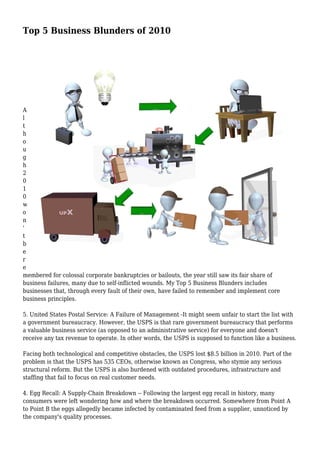
Top 5 Business Blunders of 2010
- 1. Top 5 Business Blunders of 2010 A l t h o u g h 2 0 1 0 w o n ' t b e r e membered for colossal corporate bankruptcies or bailouts, the year still saw its fair share of business failures, many due to self-inflicted wounds. My Top 5 Business Blunders includes businesses that, through every fault of their own, have failed to remember and implement core business principles. 5. United States Postal Service: A Failure of Management -It might seem unfair to start the list with a government bureaucracy. However, the USPS is that rare government bureaucracy that performs a valuable business service (as opposed to an administrative service) for everyone and doesn't receive any tax revenue to operate. In other words, the USPS is supposed to function like a business. Facing both technological and competitive obstacles, the USPS lost $8.5 billion in 2010. Part of the problem is that the USPS has 535 CEOs, otherwise known as Congress, who stymie any serious structural reform. But the USPS is also burdened with outdated procedures, infrastructure and staffing that fail to focus on real customer needs. 4. Egg Recall: A Supply-Chain Breakdown -- Following the largest egg recall in history, many consumers were left wondering how and where the breakdown occurred. Somewhere from Point A to Point B the eggs allegedly became infected by contaminated feed from a supplier, unnoticed by the company's quality processes.
- 2. Supply chain failures occur for many reasons: cost, complacency, relying on past practices, and focusing on the wrong metrics. Instead of treating the supply chain as an integrated process in their overall production line, businesses fall back on faulty performance metrics that don't lead to a better or more consistent product. 3. Toyota Recall: A Failure of Design -- The Toyota recall shares a major characteristic with the egg recall: supply-chain breakdown. Subsequent investigations, however, revealed that a major contributing cause were design issues that led to consumer error. The fault still rests with Toyota, who failed recognize the design issue, even when faced with consumer complaints. The lesson for businesses is that keeping the lines of communication open between the consumer and management is almost as important as ensuring you're building a safe product. If a product is only safe under certain specific conditions, but becomes dangerous under others, it's back to the drawing board. 2. Health Care Reform: A Failure to Define Goals and Test - No, it's not a business. But the law's unfavorable approval ratings stem in part from its authors' inability to articulate a clear purpose, thus holding an important message for business. Like any major company initiative, unless you're clear on your goal, those tasked with developing and implementing the reform will fail to deliver. That's precisely what happened with "Obamacare." This is good lesson for any CEO. The administration was never able to succinctly explain the reason behind the massive reform. Was it to reduce healthcare costs? Was it to insure more people? Was it to improve the quality of care? The administration made the case on all three fronts, leading to mass confusion with the public -- the customers. And the massive initiative is being implemented without any beta testing on a limited scale. Relying on pie in the sky promises to dramatically change a functioning system, even one that admittedly needs improvement, without any ramp-up or implementation testing on a small scale is a recipe for disaster. If you set politics aside, and look at the health care reform from the perspective of a business, it's a great example of how not to implement transformational change. 1. BP Oil Spill: A Failure of Leadership and Metrics: The Deep Horizon oil rig explosion is clearly the biggest business blunder of 2010. At the most basic level, BP suffered from a failure to balance competing objectives. Tony Hayward began as BP's CEO in May 2007 with a promise to focus "like a laser" on safety concerns, as well as operating performance. The metaphor proved to be all too apt: A laser can focus on only one thing at a time. It appears that BP failed to focus on the right target. What's likely is that BP's management believed they were meeting all safety performance targets, or at least gaining on them, because they were spending millions of dollars to improve safety. By the metrics they had created, the company might well have been making progress. The metrics they chose were the problem. The point for all businesses is that making safety a priority and throwing resources at it without appropriate metrics may lead to very bad outcomes. Lisa W. Hershman is the CEO of Hammer and Co., a Boston-based business education and research firm, and co-author with Michael Hammer of the newly released book, "Faster, Cheaper, Better: The 9 Levers for Transforming How Work Gets Done." http://www.foxnews.com/opinion/2010/12/30/business-blunders/